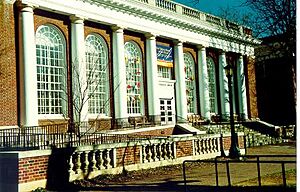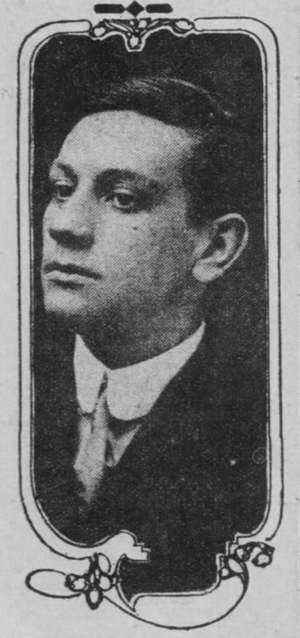Dumas Malone facts for kids
Quick facts for kids
Dumas Malone
|
|
|---|---|
 |
|
| Born | 10 January 1892 Coldwater, Mississippi, U.S.
|
| Died | 27 December 1986 (aged 94) |
| Education | Emory College (BA) Yale University (BDiv, MA, PhD) |
|
Notable work
|
Jefferson and His Time |
| Spouse(s) |
Elizabeth Gifford
(m. 1925) |
| Relatives | Kemp Malone (brother) |
| Awards | Pulitzer Prize for History (1975) Presidential Medal of Freedom (1983) |
| Signature | |
Dumas Malone (DEW-mah; January 10, 1892 – December 27, 1986) was an American historian, minister, and writer. He was a professor for most of his career. Malone taught at the University of Virginia (UVA), where he was the Thomas Jefferson Foundation Professor of History.
Malone was famous for his six-book series called Jefferson and His Time. This series won him the 1975 Pulitzer Prize for History. He finished the books in 1981. This collection became his most important work and is seen as the best biography of Thomas Jefferson. Before becoming a biographer, he was the main editor for the twenty-book Dictionary of American Biography. He also directed the Harvard University Press. In 1983, President Ronald Reagan gave him the Presidential Medal of Freedom.
Contents
Early Life and Education
Growing Up and School
Dumas Malone was born in Coldwater, Mississippi, on January 10, 1892. His father, John W. Malone, was a minister. His mother, Lillian Kemp, was a teacher who supported women's right to vote. He grew up in a religious family in the Deep South. His parents were educators who believed in learning. His mother helped him love reading, and his father worked at different schools.
The family moved to Oxford, Mississippi, and later to Brunswick, Georgia. In 1902, Malone's father became the president of Andrew College.
In 1906, Malone started at Emory College (now Emory University) when he was just 14. He earned his Bachelor of Arts degree in 1910. He studied classic subjects like Latin and Greek. He also found inspiration from his history teacher, Edgar H. Johnson.
Malone played football for his class team. He was also part of the Sigma Nu fraternity. Even though he felt he wasn't a great student, he loved his time at Emory.
From Ministry to History at Yale
After college, Malone first wanted to study religion and become a minister. He taught at small schools, including Andrew College, where he taught mathematics, history, and the Bible. He found he loved teaching. He also taught biblical literature at Randolph-Macon Woman's College.
After a year at Vanderbilt University, Malone went to Yale Divinity School. He did very well there and earned a Bachelor of Divinity degree in 1916. He found that he loved writing and decided to study history instead of theology.
His studies were stopped by World War I. He joined the U.S. Marine Corps in 1917. He became a Second lieutenant. The war ended before he saw combat, and he left the Marines in 1919. Malone then went back to Yale to get his history doctorate. He also started teaching American history to college students.
In 1921, Malone earned his master's degree. In 1923, he received his Doctor of Philosophy (PhD) in history. His main paper, "The Public Life of Thomas Cooper", won an award. His advisor, Allen Johnson, suggested the topic. This paper later became Malone's first book in 1926. After finishing his PhD, Malone was asked to join the faculty at the University of Virginia.
Career Highlights
Starting at Virginia and the DAB

In 1923, Malone became a history professor at the University of Virginia. His office was on the top floor of the Alderman Library. He taught courses in European and American history. He also started new courses in colonial history and modern American history.
While at the University of Virginia, Malone became very interested in the life of Thomas Jefferson. Jefferson was the university's founder. In 1924, Malone wrote a short summary of Jefferson's life. By 1926, he decided to write a long biography about Jefferson. In 1927, he traveled to France with his wife, Elizabeth Gifford, to do more research.
Malone's time at Virginia ended when his former mentor, Allen Johnson, asked him to be a co-editor for the huge Dictionary of American Biography (DAB) in 1929. Malone found it hard to leave the University of Virginia. He moved to Washington, D.C., to work on the dictionary. In 1931, Johnson died in a car accident. This made Malone the main editor of the DAB until 1936. The dictionary was finished in 1942. It had twenty books and involved over 2,000 other biographers.
Malone found editing the DAB to be a lot of hard work. However, he learned a lot about being precise and clear in his writing. This experience helped him greatly with his future biography of Jefferson.
Leading Harvard University Press
In 1935, Malone was asked to become the third director of the Harvard University Press (HUP). He accepted and started his new role on December 1, 1937. He moved with his family to Lincoln, Massachusetts.
Malone had a new idea for the Press. He wanted to publish books for everyone, not just for scholars. He called this "scholarship plus." He made many big changes at the Press. He hired new staff and brought in important scholars. Harvard's president, James B. Conant, even offered Malone a history professor title, but Malone said no.
Malone believed the Harvard University Press was mainly an academic place, not just a business. Under his leadership, the Press became very successful. It published several important books, including two that won Pulitzer Prizes. Sales doubled, and the Press became known for its important publications.
However, during World War II, the Press faced money problems. Sales went down, and Malone's relationship with the university leaders became difficult. In 1943, Malone's pay and duties were cut. Many officials doubted his leadership. On July 17, he resigned, saying that the way his work was judged was different from how academic departments were judged. The university accepted his resignation. In April 1943, Malone officially left his job as director. He returned to Virginia to start writing his Jefferson biography. He and his family moved to Charlottesville, Virginia, that summer.
Back to Virginia and Jefferson
After leaving Harvard, Malone focused on writing the first book of his Jefferson biography. He had signed a contract for a multi-volume biography of Thomas Jefferson in 1938. To help with his finances, the Rockefeller Foundation gave him a grant of $21,000 in May 1944. The University of Virginia helped him get this grant by giving him an honorary position.
In 1945, Columbia University offered Malone a history professor position. He was worried it would stop his work on the Jefferson biography. But he accepted when the Rockefeller Foundation changed the terms of his grant to allow part-time teaching. While teaching at Columbia, he became friends with John A. Krout and Allan Nevins.
In 1947, Malone finished his first book, Jefferson the Virginian. It was published on Jefferson's birthday the next year. Scholars praised the book, and it was well-received by readers. One historian, Merle Curti, said the story was clear and straightforward. Another historian, Thomas D. Clark, said this first book was the start of a very important series that would bring Jefferson to many readers.
Legacy and Honors
Malone received many honors throughout his life. He was chosen for the American Academy of Arts and Sciences in 1936. He also received honorary degrees from Dartmouth College and the University of Rochester. He was awarded a Guggenheim Fellowship in 1951 and 1958.
In 1972, he received Yale University's Wilbur L. Cross Medal. He also got the John F. Kennedy Medal from the Massachusetts Historical Society. In 1975, he won the Pulitzer Prize for History. At that time, he was the oldest person to receive this award. In 1982, he won The Award for Distinguished Service to the Humanities from the Phi Beta Kappa Society.
In 1983, President Ronald Reagan gave Malone the Presidential Medal of Freedom. Malone was also a member of the Virginia Historical Society. The Thomas Jefferson Memorial Foundation created the Dumas Malone Graduate Research Fellowship at the University of Virginia in his honor. This fellowship helps advanced graduate students with their research.
When Queen Elizabeth II visited Charlottesville, Virginia, in 1976, Governor Mills Godwin gave her the first five books of Jefferson and His Time. The sixth book had not yet been finished.
Malone also published a set of lectures called Thomas Jefferson as Political Leader (1963).
Personal Life and Death

Dumas Malone married Elizabeth Gifford in 1925. They had two children together. He passed away on December 27, 1986, at his home in Charlottesville, Virginia. The University of Virginia said he died after a short illness. He is buried at the University of Virginia Cemetery and Columbarium.
Selected Publications
Jefferson and His Time




